This article is about the galaxy. For other uses, see Milky Way (disambiguation).
 An image of the Milky Way's Galactic Center in the night sky above Paranal Observatory | |
| Observation data | |
|---|---|
| Type | SBc (barred spiral galaxy) |
| Diameter | 100,000-120,000 light-years: (30-37 kpc)[1][2][unreliable source?] |
| Thickness | 1,000 light-years[1] |
| 2 Dimensional Volume | ~7.85 trillion square light-years[citation needed] |
| Number of stars | 300±100 billion [3][4] |
| Oldest known star | 13.2 billion years[5] |
| Mass | 1.0-1.5×1012 M☉ (2-3×1042 kg) [6] |
| Sun's distance toGalactic Center | 27,200 ± 1,100 light-years[7] |
| Sun's galactic rotation period | 250 million years (negative rotation)[8] |
| Spiral pattern rotation period | 50 million years[9] |
| Bar pattern rotation period | 15 to 18 million years[9] |
| Speed relative toCMB rest frame | 552 km/s[10] |
| See also: Galaxy, List of galaxies | |
The Milky Way is the galaxy that contains the Solar System.[11][a] This name derives from its appearance as a dim un-resolved "milky" glowing band arching across the night sky. The term "Milky Way" is a translation of the Latin for "milky road", Via Lactea, in turn derived from the Greek kyklos galaktikos or "milky circle", "milk" also being the root for the Greek word for galaxy, γαλαξίας (galaxias).[12][13]
The galaxy has this appearance because it is a disk-shaped structure that is being viewed edge-on. Earth is located within thegalactic plane of this disk, around two thirds of the way out from the center, on the inner edge of a spiral-shaped concentration of gas and dust called the Orion–Cygnus Arm. The concept of this faint band of light being made up of stars was proven in 1610 when Galileo Galilei used his telescope to resolve it into individual stars. In the 1920s observations by astronomer Edwin Hubbleshowed that the Milky Way was just one of around 200 billion galaxies in the observable universe.
The Milky Way is a barred spiral galaxy 100,000-120,000 light-years in diameter containing 200–400 billion stars. The galaxy is estimated to contain at least as many planets, 10 billion of which could be located in the habitable zone of their parent star.[14]Depending on its structure the entire galaxy has a rotational rate of once every 15 to 50 million years. The galaxy is also moving at a velocity of 552 to 630 km per second, depending on the relative frame of reference. It is estimated to be about 13.2 billion years old, nearly as old as the Universe. The Milky Way is part of the Local Group of galaxies.
Contents[hide] |
[edit]Appearance
All the stars that can be seen in the night sky are part of the Milky Way galaxy, but for the purposes of the astronomical activity of observing the celestial sphere the term "Milky Way" is limited to the hazy band of white light arching around the entire night sky.[15] The light originates from un-resolved stars and other material that lie within the galactic plane. Dark regions within the band, such as the Great Riftand the Coalsack, correspond to areas where light from distant stars is blocked by dark nebulae.
The Milky Way has a relatively low surface brightness, with its visibility being greatly affected by the brightness of the night sky due to light pollution, stray light from the moon, and so forth. It becomes readily visible at limiting magnitudes of +5.1 or better, while showing a great deal of detail at +6.1.[16] This makes the Milky Way difficult to see from any brightly-lit urban or suburban location, but very prominent when viewed from a rural area.[17]
The center of the galaxy lies in the direction of the constellation Sagittarius, and it is here that the Milky Way looks brightest. From Sagittarius, the hazy band of white light appears to pass westward through the constellations of Scorpius, Ara, Norma, Triangulum Australe,Circinus, Centaurus, Musca, Crux, Carina, Vela, Puppis, Canis Major, Monoceros, Orion and Gemini, Taurus, to the galactic anticenter inAuriga. From there, it passes through Perseus, Andromeda, Cassiopeia, Cepheus and Lacerta, Cygnus, Vulpecula, Sagitta, Aquila,Ophiuchus, Scutum, and back to Sagittarius. The fact that the band divides the night sky into two roughly equal hemispheres indicates that the Solar System lies close to the galactic plane.
The galactic plane is inclined by about 60 degrees to the ecliptic (the plane of the Earth's orbit). Relative to the celestial equator, it passes as far north as the constellation of Cassiopeia and as far south as the constellation of Crux, indicating the high inclination of Earth's equatorial plane and the plane of the ecliptic relative to the galactic plane. The north galactic pole is situated at right ascension 12h 49m, declination+27.4° (B1950) near beta Comae Berenices, and the south galactic pole is near alpha Sculptoris.
[edit]Size
The stellar disk of the Milky Way galaxy is approximately 100,000 light-years (30 kiloparsecs, 9×1017 km) in diameter, and is considered to be, on average, about 1,000 ly (0.3 kpc) thick.[1] It is estimated to contain at least 100 billion stars[18] and possibly up to 400 billion stars.[19] The exact figure depends on the number of very low-mass, or dwarf stars, which are hard to detect, especially at distance of more than 300 ly (90 pc) from the Sun. Hence, current estimates of the total number remain highly uncertain, though it is often speculated to be around 250 billion.[citation needed] This can be compared to the one trillion (1012) stars of the neighboring Andromeda Galaxy.[20]
The disc of stars in the Milky Way does not have a sharp edge; a radius beyond which there are no stars. Rather, the concentration of stars drops smoothly with distance from the center of the galaxy. Beyond a radius of roughly 40,000 ly (12 kpc), the number of stars per cubic parsec drops much faster with radius,[21] for reasons that are not understood. Recent[when?]estimates give the galaxy a population of at least 50 billion planets, 10 billion of which could be located in the habitable zone of their parent star.[22][23] New data[when?] suggests there may be up to twice as many free-floating planets in the Milky Way as there are stars.[24] In 2011, new evidence obtained via gravitational microlensing indicated an average of at least one bound planet per star in the Milky Way, with Earth-sized planets being more numerous than gas giants.[14]
Extending beyond the stellar disk is a much thicker disk of gas. Recent[when?] observations indicate that the gaseous disk of the Milky Way has a thickness of around 12,000 ly (3.7 kpc)—twice the previously accepted value.[25]
As a guide to the relative physical scale of the Milky Way, if the Solar System out to the orbit of Pluto were reduced to the size of a US quarter (approximately 2.5 cm in diameter) the Milky Way would span some 2,045 km across covering an area of 3.286 million square kilometers, an area equivalent to about a third of the United States (3.276 million square km), the total area of India (3.287 million square km), or the combined areas of Great Britain, France, Spain, Germany, Italy, Poland, Sweden, Finland and Norway (3.378 million square km).[26]
The Galactic Halo extends outward, but is limited in size by the orbits of two Milky Way satellites, the Large and the Small Magellanic Clouds, whose perigalacticon is at about 180,000 ly (55 kpc).[27] At this distance or beyond, the orbits of most halo objects would be disrupted by the Magellanic Clouds, and the objects would likely be ejected from the vicinity of the Milky Way.
[edit]Age
The ages of individual stars in the Milky Way can be estimated by measuring the abundance of long-lived radioactive elements such asthorium-232 and uranium-238, then comparing the results to estimates of their original abundance. These yield values of about 14.0 ± 2.4 Gafor CS 31082-001 and 13.8 ± 4 Ga for BD+17° 3248. Once a white dwarf star is formed, it begins to undergo radiative cooling and the surface temperature steadily drops. By measuring the temperatures of the coolest of these white dwarfs and comparing them to their expected initial temperature, an age estimate can be made. With this technique, the age of the globular cluster M4 was estimated as 12.7 ± 0.7 Ga. Globular clusters are among the oldest objects in the Milky Way galaxy, which thus set a lower limit on the galaxy age. Age estimates of the oldest of these clusters gives a best fit estimate of 12.6 Ga, and a 95% confidence upper limit of 16 Ga.[28]
In 2007, a star in the Galactic halo, HE 1523-0901, was estimated to be about 13.2 billion years old, nearly as old as the Universe. As the oldest known object in the Milky Way at that time, it placed a lower limit on the age of the Milky Way.[5][not in citation given][improper synthesis?]This estimate was determined using the UV-Visual Echelle Spectrograph of the Very Large Telescope to measure the relative strengths ofspectral lines caused by the presence of Thorium and other elements created by the R-process. The line strengths yield abundances of different elemental isotopes, from which an estimate of the age of the star can be derived using nucleocosmochronology.[5]
The age of stars in the Galactic thin disk can be estimated in the same way as HE 1523-0901.[citation needed] Measurements of thin disk stars yield an estimate that the thin disk formed between 8.8 ± 1.7 billion years ago. These measurements suggest there was a hiatus of almost 5 billion years between the formation of the Galactic halo and the thin disk.[29]
[edit]Composition and structure
The galaxy consists of a bar-shaped core region surrounded by a disc of gas, dust and stars forming four distinct arm structures spiraling outward in a logarithmic spiral shape (see Spiral arms). The mass distribution within the galaxy closely resembles the Sbc Hubble classification, which is a spiral galaxy with relatively loosely wound arms.[31] Astronomers first began to suspect that the Milky Way is abarred spiral galaxy, rather than an ordinary spiral galaxy, in the 1990s.[32] Their suspicions were confirmed by the Spitzer Space Telescopeobservations in 2005[33] that showed the galaxy's central bar to be larger than previously suspected.
Estimates for the mass of the Milky Way vary, depending upon the method and data used. Recent estimates at the low end have placed the mass of the Milky Way at 5.8×1011 solar masses (M☉), somewhat smaller than the Andromeda Galaxy.[34][35][36] Other measurements by the Very Long Baseline Array (VLBA) have found velocities as large as 254 km/s for stars at the edge of the Milky Way, higher than the previously accepted value of 220 km/s.[37] As the orbital velocity depends on the mass enclosed, this implies that the Milky Way is more massive, roughly equaling the mass of Andromeda Galaxy at 7×1011 M☉ within 50 kiloparsecs (160,000 ly) of its center.[38] A recent measurement of the radial velocity of halo stars finds the mass enclosed within 80 kiloparsecs is 7×1011 M☉.[39] Most of the mass of the galaxy is thought to be dark matter, which forms a dark matter halo that is spread out relatively uniformly to a distance beyond one hundred kiloparsecs from the Galactic Center. Modelling of the Milky Way suggests that the overall mass of the entire galaxy lies in the range 1-1.5×1012 M☉[6]
This mass in baryonic matter is estimated to include 200 to 400 billion stars.[40] Its integrated absolute visual magnitude has been estimated to be −20.9.[41]
[edit]Galactic Center
The galactic disc, which bulges outward at the Galactic Center, has a diameter of 70,000–100,000 light-years (20–30 kpc).[42] The exact distance from the Sun to the Galactic Center is actively debated. The latest estimates from geometric-based methods and standard candlesyield distances to the Galactic Center of 8.0–8.7 kpc (26,000–28,000 ly).[7][43][44][45][46] The fact that the estimates span nearly 1 kpc only underscores the true uncertainty associated with the distance to the Galactic Center.
The Galactic Center harbors a compact object of very large mass as determined by the motion of material around the center.[47] The intense radio source named Sagittarius A*, thought to mark the center of the Milky Way, is confirmed to be a supermassive black hole.[48] Most galaxies are believed to have supermassive black holes at their centers.[49]
The nature of the galaxy's bar is also actively debated, with estimates for its half-length and orientation spanning from 1–5 kpc (3,300–16,000 ly) (short or a long bar) and 10–50 degrees.[45][46][50] Certain authors advocate that the galaxy features two distinct bars, one nestled within the other.[51] The bar is delineated by red clump stars, however, RR Lyr variables do not trace a prominent Galactic bar.[46][52][53] The bar may be surrounded by a ring called the "5-kpc ring" that contains a large fraction of the molecular hydrogen present in the galaxy, as well as most of the Milky Way's star formation activity. Viewed from the Andromeda Galaxy, it would be the brightest feature of our own galaxy.[54]
[edit]Spiral arms
Maps of the Milky Way's spiral structure are notoriously uncertain and exhibit striking differences.[55][56][30][57][58][59][60][61] Some 150 years after Alexander (1852)[62] first suggested that the Milky Way was a spiral, there is currently no consensus on the number or nature of the Galaxy's spiral arms. Perfect logarithmic spiral patterns ineptly describe features near the Sun,[55][60] namely since galaxies commonly exhibit arms that branch, merge, twist unexpectedly, and feature a degree of irregularity.[60][46][61] The possible scenario of the Sun within a spur / Local arm[55] emphasizes that point and indicates that such features are likely not unique, and exist elsewhere in the galaxy.[60]
Each spiral arm describes a logarithmic spiral (as do the arms of all spiral galaxies) with a pitch of approximately 12 degrees. Until recently, there were believed to be four major spiral arms which all start near the galaxy's center. These are named as follows, according to the image at right:
| Color | Arm(s) |
|---|---|
| cyan | 3-kpc and Perseus Arm |
| purple | Norma and Outer arm (Along with a newly discovered extension) |
| green | Scutum–Centaurus Arm |
| pink | Carina–Sagittarius Arm |
| There are at least two smaller arms or spurs, including: | |
| orange | Orion–Cygnus Arm (which contains the Sun and Solar System) |
Observations presented in 2008 by Robert Benjamin of the University of Wisconsin–Whitewater suggest that the Milky Way possesses only two major stellar arms: the Perseus arm and the Scutum-Centaurus arm. The rest of the arms are minor or adjunct arms.[30] This would mean that the Milky Way is similar in appearance to NGC 1365.
Outside of the major spiral arms is the Monoceros Ring (or Outer Ring), proposed by astronomers Brian Yanny and Heidi Jo Newberg, a ring of gas and stars torn from other galaxies billions of years ago.
As is typical for many galaxies, the distribution of mass in the Milky Way galaxy is such that the orbital speed of most stars in the galaxy does not depend strongly on their distance from the center. Away from the central bulge or outer rim, the typical stellar velocity is between 210 and 240 km/s.[63] Hence the orbital period of the typical star is directly proportional only to the length of the path traveled. This is unlike the situation within the Solar System, where two-body gravitational dynamics dominate and different orbits are expected to have significantly different velocities associated with them. This difference is one of the major pieces of evidence for the existence of dark matter. Another interesting aspect is the so-called "wind-up problem" of the spiral arms. If the inner parts of the arms rotate faster than the outer part, then the galaxy will wind up so much that the spiral structure will be thinned out. But this is not what is observed in spiral galaxies; instead, astronomers propose that the spiral pattern is a density wave emanating from the Galactic Center. This can be likened to a moving traffic jam on a highway—the cars are all moving, but there is always a region of slow-moving cars. This model also agrees with enhanced star formation in or near spiral arms; the compressional waves increase the density of molecular hydrogen and protostars form as a result.
[edit]Halo
The galactic disk is surrounded by a spheroid halo of old stars and globular clusters, of which 90% lie within 100,000 light-years (30 kpc),[64] suggesting a stellar halo diameter of 200,000 light-years. However, a few globular clusters have been found farther, such as PAL 4 and AM1 at more than 200,000 light-years away from the Galactic Center. About 40% of these clusters are on retrograde orbits, which means they move in the opposite direction from the Milky Way rotation.[65] The globular clusters can follow rosette orbits about the galaxy, in contrast to the elliptical orbit of a planet.[66]
While the disk contains gas and dust which obscure the view in some wavelengths, the spheroid component does not. Active star formation takes place in the disk (especially in the spiral arms, which represent areas of high density), but not in the halo. Open clusters also occur primarily in the disk.
Discoveries in the early 21st century have added dimension to the knowledge of the Milky Way's structure. With the discovery that the disk of the Andromeda Galaxy (M31) extends much further than previously thought,[67] the possibility of the disk of the Milky Way galaxy extending further is apparent, and this is supported by evidence from the discovery of the Outer Arm extension of the Cygnus Arm.[68] With the discovery of the Sagittarius Dwarf Elliptical Galaxy came the discovery of a ribbon of galactic debris as the polar orbit of the dwarf and its interaction with the Milky Way tears it apart. Similarly, with the discovery of the Canis Major Dwarf Galaxy, it was found that a ring of galactic debris from its interaction with the Milky Way encircles the galactic disk.
On January 9, 2006, Mario Jurić and others of Princeton University announced that the Sloan Digital Sky Survey of the northern sky found a huge and diffuse structure (spread out across an area around 5,000 times the size of a full moon) within the Milky Way that does not seem to fit within current models. The collection of stars rises close to perpendicular to the plane of the spiral arms of the galaxy. The proposed likely interpretation is that a dwarf galaxy is merging with the Milky Way. This galaxy is tentatively named the Virgo Stellar Stream and is found in the direction of Virgo about 30,000 light-years (9 kpc) away.
[edit]Gamma-ray bubbles
On November 9, 2010, Doug Finkbeiner of the Harvard–Smithsonian Center for Astrophysics announced that he had detected two gigantic spherical bubbles of energy erupting to the north and the south from the center of the Milky Way, using data of the Fermi Gamma-ray Space Telescope. The diameter of each of the bubbles is about 25,000 light-years (7.7 kpc); they stretch up to Grus and to Virgo on the night-sky of the southern hemisphere. Their origin remains unclear, so far.[69][70]
[edit]Sun's location and neighborhood
The Sun (and therefore the Earth and the Solar System) may be found close to the inner rim of the galaxy's Orion Arm, in the Local Fluff inside the Local Bubble, and in the Gould Belt, at a distance of 8.33 ± 0.35 kiloparsecs (27,200 ± 1,100 ly) from the Galactic Center.[7][43][71] The Sun is currently 5–30 parsecs (16–98 ly) from the central plane of the galactic disc.[72] The distance between the local arm and the next arm out, the Perseus Arm, is about 6,500 light-years (2.0 kpc).[73] The Sun, and thus the Solar System, is found in the galactic habitable zone.
There are about 208 stars brighter than absolute magnitude 8.5 within 15 parsecs (49 ly) of the Sun, giving a density of 0.0147 such stars per cubic parsec, or 0.000424 per cubic light-year (from List of nearest bright stars). On the other hand, there are 64 known stars (of any magnitude, not counting 4 brown dwarfs) within 5 parsecs (16 ly) of the Sun, giving a density of 0.122 stars per cubic parsec, or 0.00352 per cubic light-year (from List of nearest stars), illustrating the fact that most stars are less bright than absolute magnitude 8.5.
The Apex of the Sun's Way, or the solar apex, is the direction that the Sun travels through space in the Milky Way. The general direction of the Sun's galactic motion is towards the star Vega near the constellation of Hercules, at an angle of roughly 60 sky degrees to the direction of theGalactic Center. The Sun's orbit around the galaxy is expected to be roughly elliptical with the addition of perturbations due to the galactic spiral arms and non-uniform mass distributions. In addition, the Sun oscillates up and down relative to the galactic plane approximately 2.7 times per orbit. This is very similar to how a simple harmonic oscillator works with no drag force (damping) term. These oscillations were until recently thought to coincide with mass extinction periods on Earth.[74] However, a reanalysis of the effects of the Sun's transit through the spiral structure based on CO data has failed to find these correlations.[75]
It takes the Solar System about 225–250 million years to complete one orbit of the galaxy (a galactic year),[76] so it is thought to have completed 18–20 orbits during the lifetime of the Sun and 1/1250 of a revolution since the origin of humans. The orbital speed of the Solar System about the center of the galaxy is approximately 220 km/s or 0.073% of the speed of light. At this speed, it takes around 1,400 years for the Solar System to travel a distance of 1 light-year, or 8 days to travel 1 AU (astronomical unit).[77]
[edit]Environment
The Milky Way and the Andromeda Galaxy are a binary system of giant spiral galaxies belonging to a group of 50 closely bound galaxies known as the Local Group, itself being part of the Virgo Supercluster.
Two smaller galaxies and a number of dwarf galaxies in the Local Group orbit the Milky Way. The largest of these is the Large Magellanic Cloud with a diameter of 20,000 light-years. It has a close companion, the Small Magellanic Cloud. The Magellanic Stream is a peculiar streamer of neutral hydrogen gas connecting these two small galaxies. The stream is thought to have been dragged from the Magellanic Clouds in tidal interactions with the Milky Way. Some of the dwarf galaxies orbiting the Milky Way are Canis Major Dwarf (the closest),Sagittarius Dwarf Elliptical Galaxy, Ursa Minor Dwarf, Sculptor Dwarf, Sextans Dwarf, Fornax Dwarf, and Leo I Dwarf. The smallest Milky Way dwarf galaxies are only 500 light-years in diameter. These include Carina Dwarf, Draco Dwarf, and Leo II Dwarf. There may still be undetected dwarf galaxies, which are dynamically bound to the Milky Way, as well as some that have already been absorbed by the Milky Way, such asOmega Centauri. Observations through the Zone of Avoidance are frequently detecting new distant and nearby galaxies. Some galaxies consisting mostly of gas and dust may also have evaded detection so far.
In January 2006, researchers reported that the heretofore unexplained warp in the disk of the Milky Way has now been mapped and found to be a ripple or vibration set up by the Large and Small Magellanic Clouds as they circle the galaxy, causing vibrations at certain frequencies when they pass through its edges.[78] Previously, these two galaxies, at around 2% of the mass of the Milky Way, were considered too small to influence the Milky Way. However, by taking into account dark matter, the movement of these two galaxies creates a wake that influences the larger Milky Way. Taking dark matter into account results in an approximately twentyfold increase in mass for the galaxy. This calculation is according to a computer model made by Martin Weinberg of the University of Massachusetts, Amherst. In this model, the dark matter is spreading out from the galactic disc with the known gas layer. As a result, the model predicts that the gravitational effect of the Magellanic Clouds is amplified as they pass through the galaxy.
Current measurements suggest the Andromeda Galaxy is approaching us at 100 to 140 kilometers per second. The Milky Way may collidewith it in 3 to 4 billion years, depending on the importance of unknown lateral components to the galaxies' relative motion. If they collide, individual stars within the galaxies would not collide, but instead the two galaxies will merge to form a single elliptical galaxy over the course of about a billion years.[79]
[edit]Velocity
In the general sense, the absolute velocity of any object through space is not a meaningful question according to Einstein's special theory of relativity, which declares that there is no "preferred" inertial frame of reference in space with which to compare the object's motion. (Motion must always be specified with respect to another object.) This must be kept in mind when discussing the galaxy's motion.
Astronomers believe the Milky Way is moving at approximately 630 km per second relative to the local co-moving frame of reference that moves with the Hubble flow.[83] If the galaxy is moving at 600 km/s, Earth travels 51.84 million km per day, or more than 18.9 billion km per year, about 4.5 times its closest distance from Pluto. The Milky Way is thought to be moving in the direction of the Great Attractor. The Local Group (a cluster of gravitationally bound galaxies containing, among others, the Milky Way and the Andromeda galaxy) is part of asupercluster called the Local Supercluster, centered near the Virgo Cluster: although they are moving away from each other at 967 km/s as part of the Hubble flow, the velocity is less than would be expected given the 16.8 million pc distance due to the gravitational attraction between the Local Group and the Virgo Cluster.[84]
Another reference frame is provided by the cosmic microwave background (CMB). The Milky Way is moving at around 552 km/s[10] with respect to the photons of the CMB, toward 10.5 right ascension, −24° declination (J2000 epoch, near the center of Hydra). This motion is observed by satellites such as the Cosmic Background Explorer (COBE) and the Wilkinson Microwave Anisotropy Probe (WMAP) as a dipole contribution to the CMB, as photons in equilibrium in the CMB frame get blue-shifted in the direction of the motion and red-shifted in the opposite direction.[citation needed]
The galaxy rotates about its center according to its galaxy rotation curve as shown in the figure. The discrepancy between the observed curve (relatively flat) and the curve based upon the known mass of the stars and gas in the Milky Way (decaying curve) is attributed to dark matter.[85]
[edit]History
[edit]Etymology
There are many creation myths around the world which explain the origin of the Milky Way and give it its name. The English phrase is a translation from Ancient Greek Γαλαξίας, Galaxias, which is derived from the word for milk (γάλα, gala). This is also the origin of the word galaxy. In Greek myth, the Milky Way was caused by milk spilt by Hera when suckling Heracles.[86]
In Sanskrit and several other Indo-Aryan languages, the Milky Way is called Akash Ganga (आकाशगंगा, Ganges of the heavens).[87] The milky way is held to be sacred in the Hindu scriptures known as the Puranas, and the Ganges and the Milky Way are considered to be terrestrial-celestial analogs of each other.[87][88] However, the term Kshira (क्षीर, milk) is also used as an alternative name for the milky way in Hindu texts.[89]
[edit]Discovery
| This section may contain inappropriate or misinterpreted citations that do not verify the text. Please help improve this articleby checking for inaccuracies. (help, talk, get involved!) (September 2010) |
As Aristotle (384–322 BC) informs us in Meteorologica (DK 59 A80), the Greek philosophers Anaxagoras (ca. 500–428 BC) and Democritus(450–370 BC) proposed the Milky Way might consist of distant stars. However, Aristotle himself believed the Milky Way to be caused by "the ignition of the fiery exhalation of some stars which were large, numerous and close together" and that the "ignition takes place in the upper part of the atmosphere, in the region of the world which is continuous with the heavenly motions."[90] The Neoplatonist philosopher Olympiodorus the Younger (c. 495–570 A.D.) criticized this view, arguing that if the Milky Way were sublunary it should appear different at different times and places on the Earth, and that it should have parallax, which it does not. In his view, the Milky Way was celestial. This idea would be influential later in the Islamic world.[91]
According to Mohaini Mohamed, the Arabian astronomer, Alhazen (965–1037 AD), refuted this by making the first attempt at observing and measuring the Milky Way's parallax,[92] and he thus "determined that because the Milky Way had no parallax, it was very remote from theearth and did not belong to the atmosphere."[93]
The Persian astronomer Abū Rayhān al-Bīrūnī (973–1048) proposed the Milky Way galaxy to be a collection of countless nebulous stars.[94] The Andalusian astronomer Avempace (d. 1138) proposed the Milky Way to be made up of many stars but appears to be a continuous image due to the effect of refraction in the Earth's atmosphere, citing his observation of aconjunction of Jupiter and Mars in 1106 or 1107 as evidence.[90] Ibn Qayyim Al-Jawziyya (1292–1350) proposed the Milky Way galaxy to be "a myriad of tiny stars packed together in the sphere of the fixed stars" and that these stars are larger than planets.[95]
According to Jamil Ragep, the Persian astronomer Naṣīr al-Dīn al-Ṭūsī (1201,1274) in his Tadhkira writes: "The Milky Way, i.e. the galaxy, is made up of a very large number of small, tightly-clustered stars, which, on account of their concentration and smallness, seem to be cloudy patches. because of this, it was likened to milk in color."[96]
Actual proof of the Milky Way consisting of many stars came in 1610 when Galileo Galilei used a telescope to study the Milky Way and discovered that it was composed of a huge number of faint stars.[97] In a treatise in 1755, Immanuel Kant, drawing on earlier work by Thomas Wright, speculated (correctly) that the Milky Way might be a rotating body of a huge number of stars, held together by gravitational forces akin to the Solar System but on much larger scales. The resulting disk of stars would be seen as a band on the sky from our perspective inside the disk. Kant also conjectured that some of the nebulae visible in the night sky might be separate "galaxies" themselves, similar to our own. Kant referred to both our galaxy and the "extragalactic nebulae" as "island universes", a term still current up to the 1930s.[98]
The first attempt to describe the shape of the Milky Way and the position of the Sun within it was carried out by William Herschel in 1785 by carefully counting the number of stars in different regions of the visible sky. He produced a diagram of the shape of the galaxy with the Solar System close to the center.
In 1845, Lord Rosse constructed a new telescope and was able to distinguish between elliptical and spiral-shaped nebulae. He also managed to make out individual point sources in some of these nebulae, lending credence to Kant's earlier conjecture.[99]
In 1917, Heber Curtis had observed the nova S Andromedae within the "Great Andromeda Nebula" (Messier object M31). Searching the photographic record, he found 11 more novae. Curtis noticed that these novae were, on average, 10 magnitudes fainter than those that occurred within our galaxy. As a result he was able to come up with a distance estimate of 150,000 parsecs. He became a proponent of the "island universes" hypothesis, which held that the spiral nebulae were actually independent galaxies.[100] In 1920 the Great Debate took place between Harlow Shapley and Heber Curtis, concerning the nature of the Milky Way, spiral nebulae, and the dimensions of the universe. To support his claim that the Great Andromeda Nebula was an external galaxy, Curtis noted the appearance of dark lanes resembling the dust clouds in the Milky Way, as well as the significant Doppler shift.[101]
The matter was conclusively settled by Edwin Hubble in the early 1920s using the Mount Wilson observatory 100 inch (2.5 m) Hooker telescope. With the light-gathering power of this new telescope he was able to produce astronomical photographs that resolved the outer parts of some spiral nebulae as collections of individual stars. He was also able to identify some Cepheid variables that he could use as abenchmark to estimate the distance to the nebulae: proving they were far too distant to be part of the Milky Way.[102] In 1936, Hubble produced a classification system for galaxies that is used to this day, the Hubble sequence.[103]




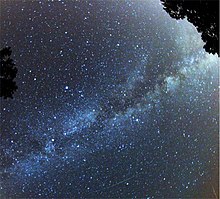
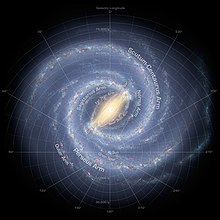
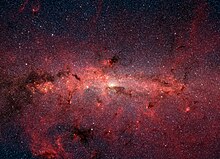
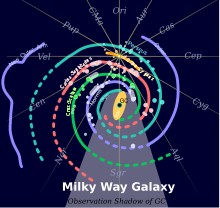
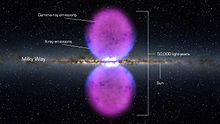






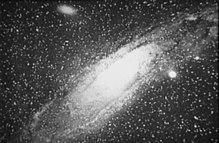





0 comments:
Post a Comment